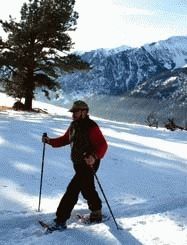SNOWSHOEING
Published 12:00 am Friday, January 23, 2004

- Fred Barstad snowshoes near Wallowa Lake. (The Observer/GARY FLETCHER).
By Dick Mason
Observer Staff Writer
Two hats.
People who snowshoe in the Wallowas might be wise to bring an extra cap if they are going to venture into back country areas.
Just ask Fred Barstad of Enterprise.
Barstad sees Rocky Mountain bighorn sheep on snowshoe trips above Lostine. Once a bighorn came close enough to steal the cap of a snowshoer Barstad was with. The cap was taken not off his head but from a nearby rock where it had been placed.
Close encounters with big game are one of the perks of snowshoeing in Northeast Oregon. Snowshoers sometimes see wildlife that cross country skiers miss because they can reach places skiers can’t. For example, snowshoers have an easier time going through thick brush than do Nordic skiers.
Snowshoers also have less difficulty reaching rocky areas where mountain goats can be found. Barstad vividly recalls the times he has come close to mountain goats in high, desolate terrain where wind has cleared rocks of snow.
"It looks like they are eating rocks but they are actually eating lichen off of them,” Barstad said.
Barstad has seen much wildlife during the 25 years he has been snowshoeing. He said that snowshoers have it much easier today because of technology. Snowshoes once consisted of wood and leather but today are made of plastic, metal and polyester. The old models were much harder to maintain, had to be waxed and were less durable.
Snowshoers today have to do little to keep up their snowshoes. In fact about the only thing one has to do to keep their snowshoes in good condition is to avoid walking over exposed rocks. This can be difficult because snowshoers encounter varied terrain.
"You may have exposed rock and then 50 feet later be up to your shoulders in snow,” Barstad said.
Easy to learn
People can learn to snowshoe quickly and do not have to be in extraordinary condition to venture on trips.
"Almost anybody in reasonably good shape can snowshoe,” Barstad said.
Still even with today’s improved equipment it is never as easy as walking.
Barstad finds that people snowshoe about half the distance they would walk. If there is a 10-mile trail a person would normally hike, that individual will likely cover five miles of the same trail on snowshoes.
The most difficult snowshoeing is going over areas where trails have to be broken. In such situations the lead person does more work by going through uncleared snow. Barstad advises groups to alternate leaders so that one person does not end up doing most of the work.
Barstad sees a lot of people who snowshoe without poles. This perplexes him because poles can be quite helpful.
"It is a real good idea to use ski poles,” Barstad said.
He recommends using poles that are a little shorter than those used for skiing.
When venturing into deep, unplowed areas it is best to use larger snowshoes because they will spread out weight more and make it easier to float on snow. Many, however, prefer using shorter snowshoes when possible because they are easier to use. In fact today’s smaller snowshoes allow one to walk with a natural gait, Barstad said.
Larger snowshoes by comparison can be awkward to use because one may step on to his or her own shoes. People who do this often "fall head first into the snow,” Barstad said.
Still larger snowshoes are best in some situations. For example, when wearing a back pack that weighs 40 to 50 pounds it is a good idea to have longer snowshoes because they will spread out the weight, said Dick Knowles, the director of Anthony Lakes Nordic Center.
The type of snowshoe needed can be determined by gender. Women generally wear narrower snowshoes than men, said Joe LeGore of Blue Mountain Sports in La Grande. LeGore said that the number of women participating in snowshoeing appears to be increasing. He said that today about 25 percent of snowshoe sales are to women.
Experience helps
Although people can learn to snowshoe quickly, everyone will benefit from years of experience. For example, over time snowshoers become more adept at going down hills.
"Some people (with experience) can almost run downhill,” Barstad said.
People who are snowshoeing for the first time won’t be running downhill but they will later run into sore muscles.
"You will find muscles that you
didn’t know you had,” Barstad said.





